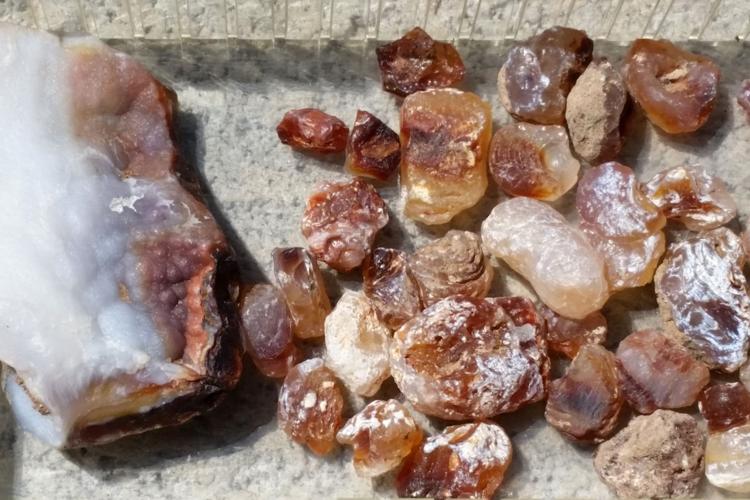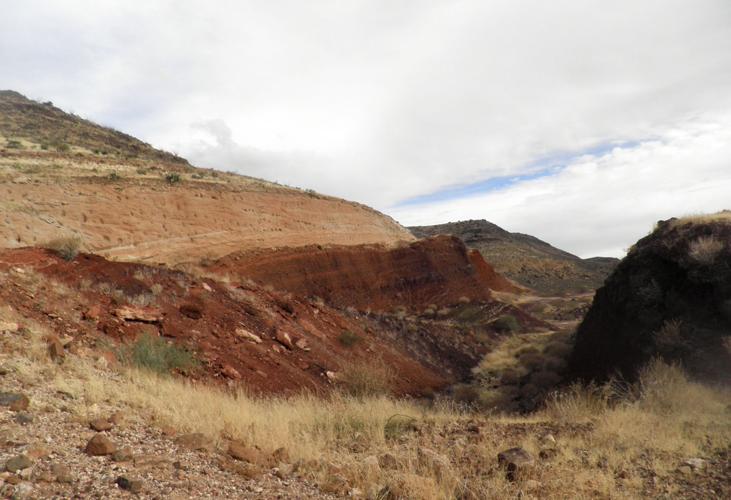The Peloncillo mining district in the Black Hills has a solid history of producing pumice and scoria as well as being a unique site for collecting fire agates.
The Black Hills are at the northern end of the Peloncillo Mountains in Graham County. Scenic access is from the 21-mile stretch of road known as the Black Hills Back Country Byway, formerly called the old Safford-Clifton Road.
The road was built by prisoners between 1914 and 1920 to expedite traffic between Safford and Clifton. Several prisoner grave sites are marked on the west side of the byway, including one of a prisoner killed by a guard in an attempted escape in 1916 and another who died of natural causes.
Geologic history of the area dates back to volcanic activity that occurred 20 million years ago. Rocks that make up the range include andesite, dacite and rhyolite. Distinctive dark gray and gray brown lava flows are mixed with light gray, red and yellow ash, forming minable deposits of cinders, tuffs and pumice.
Pumice is a result of the rapid expansion of dissolved gases from viscous siliceous magma ejected from volcanoes. Pumice is strong but lightweight. It’s also inert. It is used as aggregate for residential building blocks, insulation, landscaping and railroad ballast, and was once a popular abrasive used in the manufacture of designer jeans.
The Black Hills cinder mine operated in 1942 under the ownership of C.N. Greer, exploiting a pumice deposit averaging 80 feet thick overlying volcanic cinders.
Overburden was quarried for highway construction. A.C. Haigler’s Pumice and Pumicite Co. worked the site during the mid-1950s, later selling 200 acres to the Gila Valley Block Co., a subsidiary of the Catalina General Corp.
Commodities included pumice, cinders and perlite. According to Bill Maher, the manager of the company, production averaged 40 yards of cinders a day. Two types of blocks manufactured by the company included pumice blocks and cinder blocks.
Problems arose with the U.S. Bureau of Land Management in the 1970s over a claim fraction on the cinder mine that was later resolved in the company’s favor. The cinders were hauled from the mine to a brick plant in Safford daily using company trucks. Production was intermittent, since it was based on supply and demand.
By 1982, 34 mining claims were staked at the site, including one claim containing a projected 72 million cubic feet of pumice deposits.
In 1988 the quarry and brick plant in Safford were both for sale for $500,000. This included a portable crusher with power plant and a four-yard loader. Two diesel delivery trucks, two dump trucks, four forklifts and two tractor loaders were also included in the deal along with a building and three-bay shop on property leased from the city of Safford. Mining operations ceased at the site in late 1990.
Black Hills Rockhound Area, located just south of the cinder mine, is administered by the BLM. The area is accessible off U.S. Highway 191, just east of milepost 141 and also 3.2 miles from the access point off the Black Hills Back Country Byway.
Agate, a form of chalcedony, belongs to the quartz family of minerals. Agates result from volcanic activity that creates cavities and gas pockets in volcanic ashes. These voids were later filled by silica-rich volcanic water mixed with multiple minerals used as coloring agents. Once solidified, these cavities produced agates that are highly sought-after by collectors.
Fire agates are a variety of chalcedony containing inclusions of limonite or goethite that produce opal-like iridescence.
Recognized for collecting potential in the 1930s, fire agate is still coveted by rock hounds due to its beauty and scarcity in the southwestern United States and northern Mexico.
For a map and more information go to tinyurl.com/BlackHillsRockhound online.






